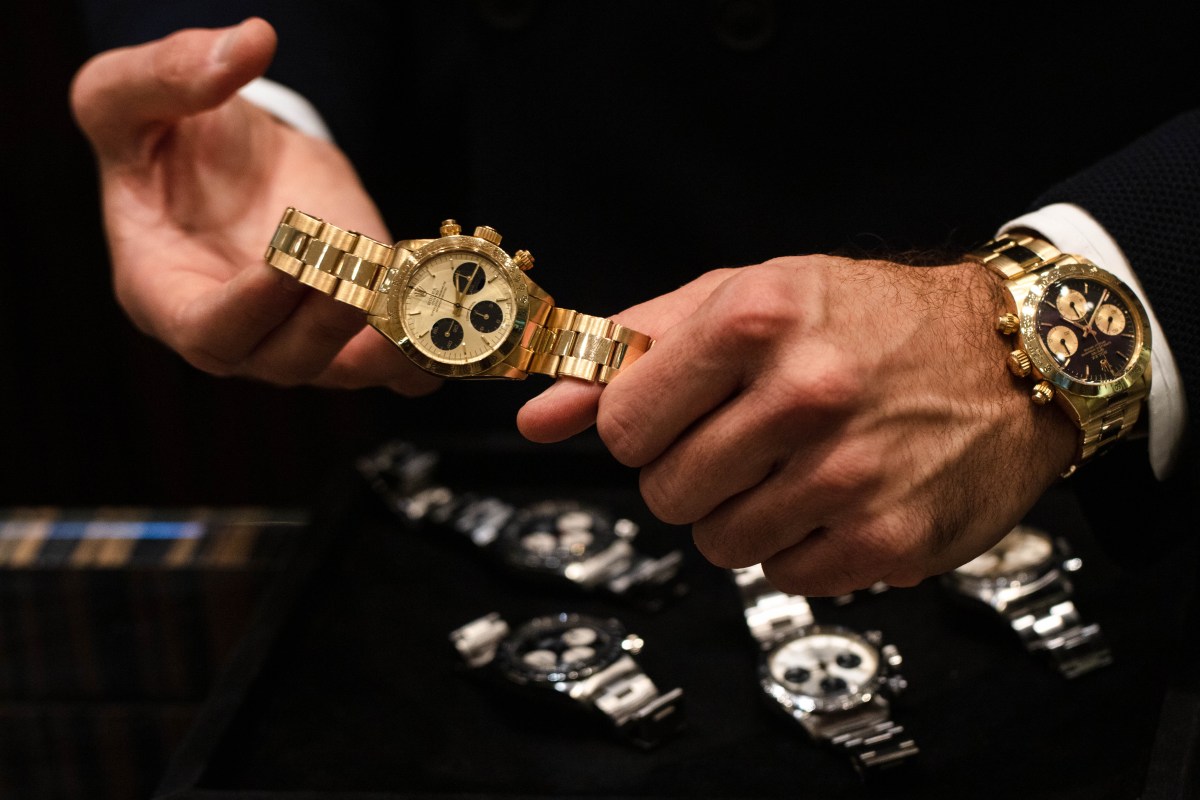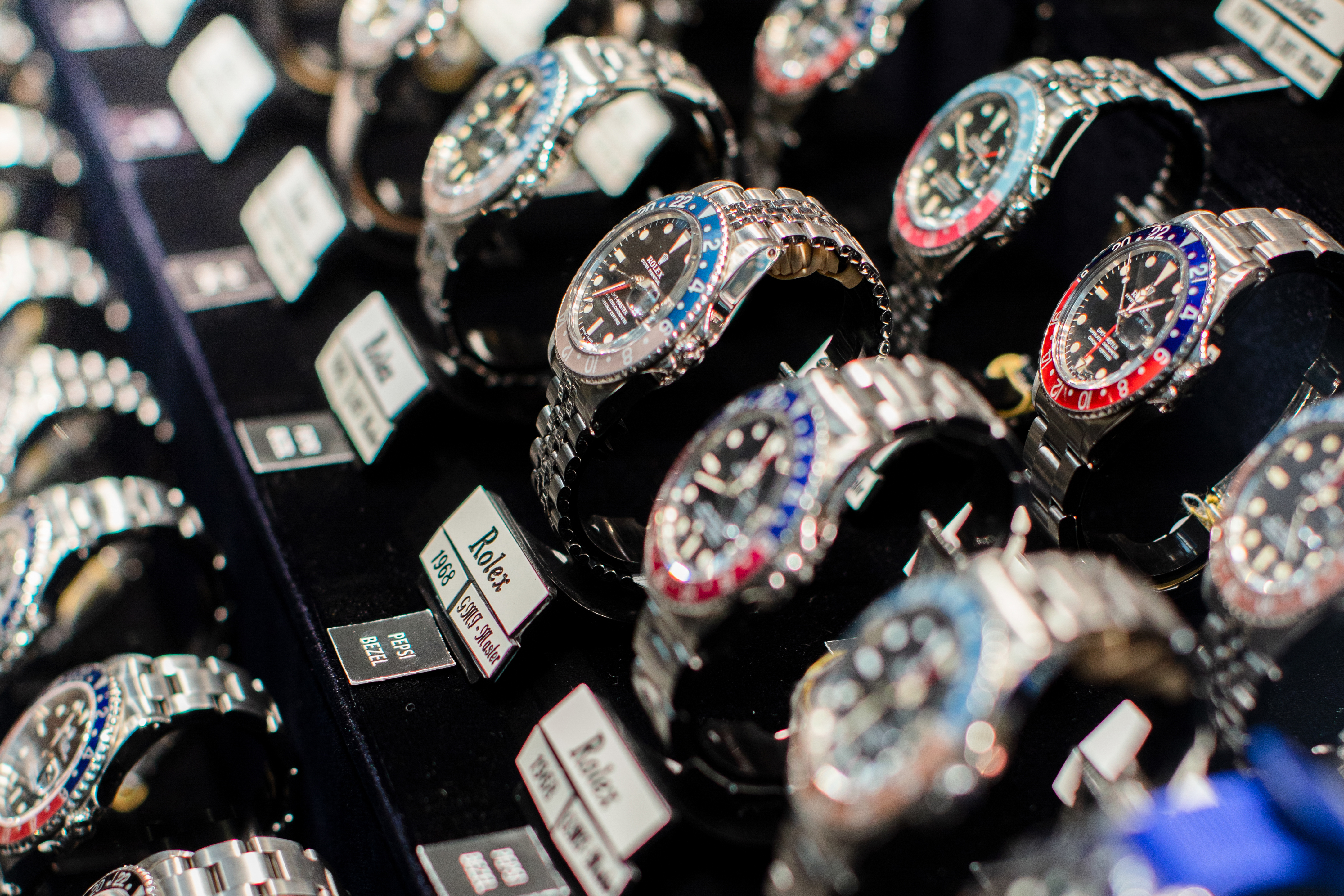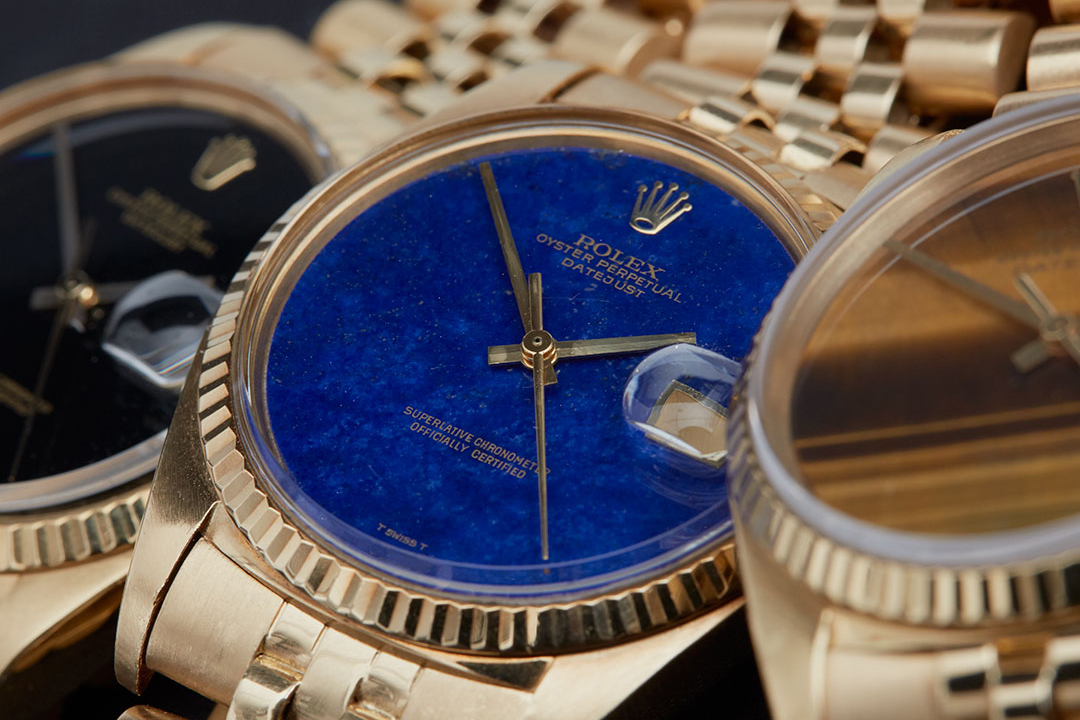
A pair of vintage Daytonas with contrasting facesVintage Watch Company
“We’re lucky in that we don’t attract the smash ’n’ grab kind of criminal,” says David Silver. “I don’t think that kind of criminal would really know what to do with what we sell. You’d need the sophisticated kind of criminal who appreciated design and history.”
All the same, Silver has a very large safe, in which, each evening, he packs away millions of dollars worth of vintage Rolex watches. Indeed, Silver, who runs The Vintage Watch Company in London’s Burlington Arcade, owns the world’s largest collection of Rolex watches.
“Of course, our inventory is always changing, but I’m the owner of every watch in our hands,” says Silver. “And if I’m buying a watch, I need to know it’s the real thing, because it’s an investment for me personally, not least because the prices paid for these pieces now means a mistake has bigger consequences. Whether it’s a £2000 or a £200,000 watch, it has to prove itself to me as a Rolex. Really, the number of dealers who don’t do [that due diligence] is extraordinary.”
Silver’s company name is, in a sense, misleading, because all he sells, globally, are vintage Rolexes — from entry-level Oysters, often bought to match the year of manufacture to a birth year, to rare pieces sought by hardcore collectors. He’s not, he says, a watch guy himself, but a retailer, competing in the wider world of fashion and design, having put the family firm’s big bet on vintage a little over 25 years ago, back when vintage was still more typically, and less appealingly, called second-hand. (Although, in watch dealing, maybe there’s a different appeal to that phrase altogether.)

“Vintage was just this very cliquey, very cool thing for a certain set to begin with. But then in 2017 Paul Newman’s Daytona was auctioned for $17.7m and became the most expensive watch sold in history, found itself on every front page, and suddenly vintage watches were perceived as desirable,” he recalls. “It’s funny, but Rolex used to be so disinterested in its past, and now it revels in tracking every model back to some origin story. Vintage now means special, individualistic.”
But, for Silver at least, is also means Rolex. He says what he does couldn’t be done with any other watch brand. Rolex has transcended horological nerdiness to become the everyman luxury watch name among the top five global brands. It’s the watch brand everyone has heard of, regardless of their interest in watches. It’s also what has allowed him to recently publish a hefty coffee table tome, Vintage Rolex: The Largest Collection in the World (Pavilion).
“Rolex has done an extraordinary job with its marketing, and still does — its ties to sport, Hollywood and so on — even to the point that it’s been criticized for running ad campaigns for watches nobody can buy,” explains Silver. “Does Rolex make the best watches in the world? No. They’re not even that rare — Rolex makes hundreds of thousands of watches every year. But there’s a genius in creating a brand and a product that’s so desirable to all creeds and walks of life. And the substance is there.”
“For me, as for a lot of people, it’s about the design, the colors, the outside of the watch,” he adds, noting that classic Rolex models the likes of the Oyster and Submariner are likely the most copied watches — by other watch brands, never mind counterfeiters — ever. “If I was in a hostage situation and had to name all the parts of a mechanical watch movement, I’d probably fail. Customers typically know more about watches than me. But I do know what sells. I know how to dress a watch up.”
He learned that from his father, John, who owned a chain of jewelry stores before selling them to a major British department store group. John Silver was, briefly, a director of that group. When he left, he did so having learned a lesson: in retail, critical mass works. Don’t just offer hand-bags in five styles, but in 55. “And my dad thought he could offer critical mass with vintage Rolexes,” says David Silver. “That also meant the pressure to sell was off — because much of our stock is steadily appreciating anyway.”
That also means that when he buys — from people who contact him about some heirloom they don’t want, from dealers, occasionally at auction — he’s also careful to make sure the watch is 100% vintage. There are plenty of very sophisticated restorations, he says, that nevertheless result in a mismatch of parts: a genuine 1960s Submariner given a genuine 1990s Rolex dial, for example. Seeing as even Rolex itself is, on occasion, a customer — filling gaps in its archive — that matters. “It’s that kind of detail I care a lot about. A watch that isn’t entirely original, entirely period correct, wouldn’t be a watch for us,” he says.
Not that The Vintage Watch Company caters to the kind of high-roller who’d likely put his purchase away in a safe and await a tidy return a few years down the line. Sure, some people come in asking for the rarest watch he has, a question Silver gently rebuffs as slightly nonsensical. “A Rolex over 100 years old is rare, but not especially valuable. Of course Daytonas are rare, but then there are GMTs that are rarer,” he says. There are, he says, watches that are so rare, and so rarefied, they become a liability — hard to move on to a broadly mainstream customer.

“Being offered a £250,000 watch is a lot of money to invest when we don’t know who might buy such a watch or when,” he explains, “and when for the same money we could buy 25 GMTs. We’ve never set out to be ‘the proud owner’ of a certain incredibly rare model … Can we sell it? We don’t get emotional about the watches; there are plenty that on paper we shouldn’t have sold because of their subsequent increase in value. But that’s not retailing. And that’s my father’s discipline there.”
“Besides, most of our customers love the watch they buy, and they’re the customers I’m interested in,” Silver explains. “It sounds pretty awful to say it, but there are plenty of people who can spend up to £20,000 on a watch without thinking much about it — and we can’t deny the business we’re in. But if you’re spending over £20,000 on a watch, which is the sweet spot, you’d better really love it.”
Of course, Silver has to keep an eye on trends: inevitably, a new release from Rolex will spark a demand for its vintage equivalent, and not least because Rolex’s extremely tight control on inventory means you likely won’t be able to get hold of a new model for some time anyway. Right now Rolexes with “stella” dials — colored ones — are hot. Right now patina matters to the horophiles, too: a “pumpkin” lume or a “tropical” dial or a “ghosted” bezel, the fading and discolorations that come only with age and that, to some, are so valued for being expressions of age that they gain their own insider terminology.
“But, truth be told, other people are horrified by patina — the idea of paying three times normal rate for something that’s distressed makes no sense to them at all,” laughs Silver.